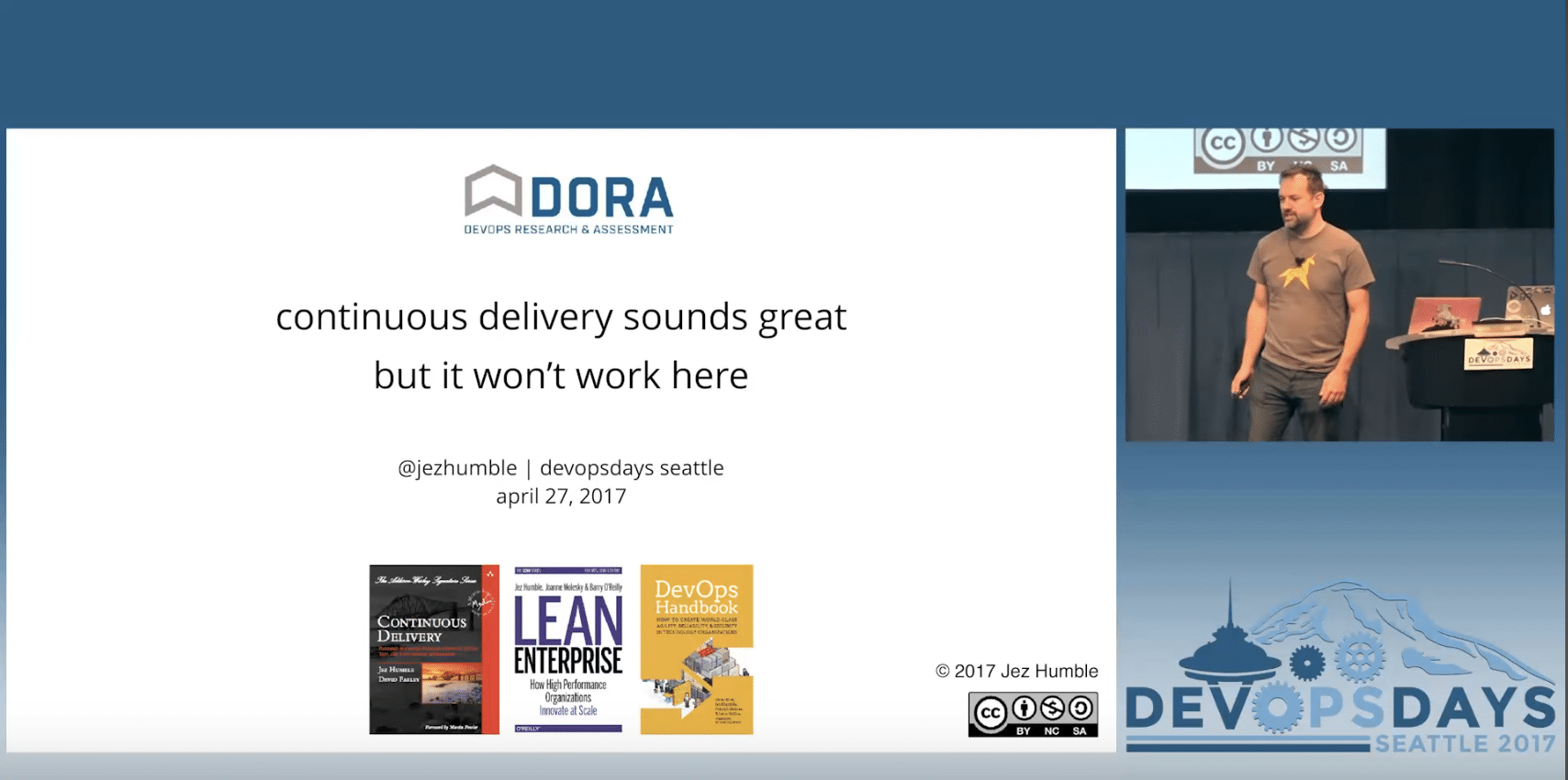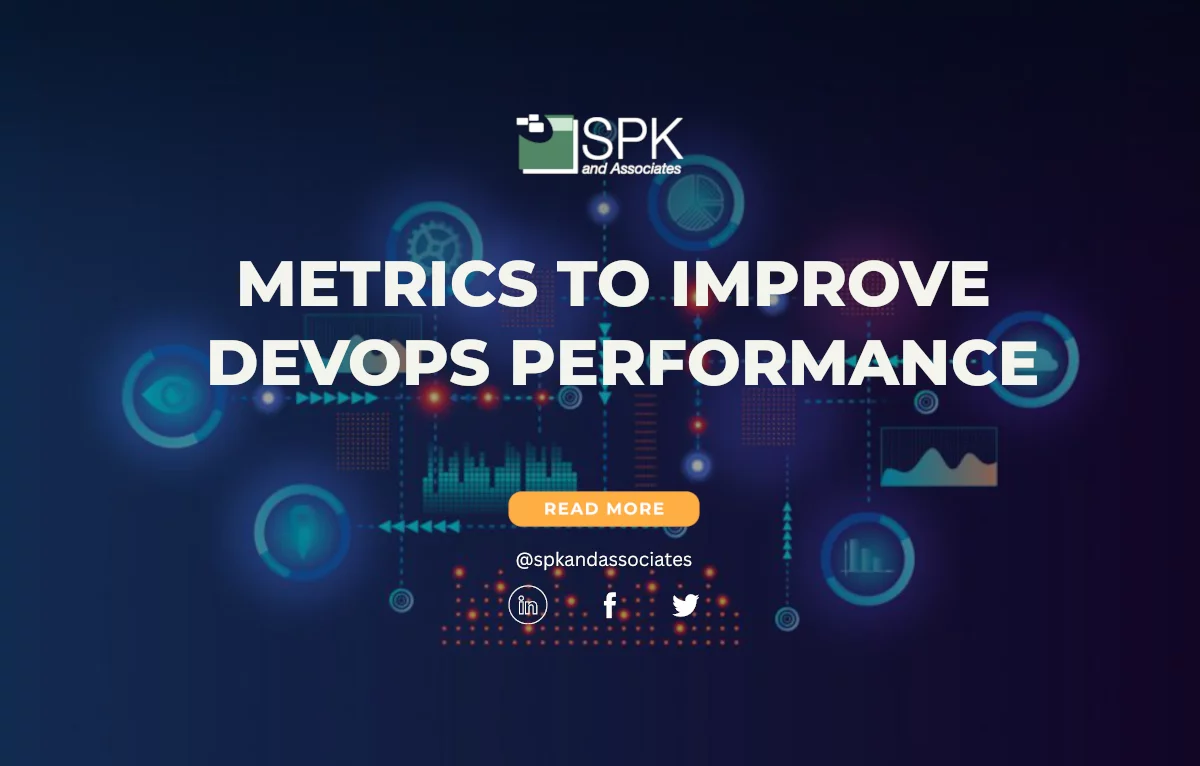DevOps has revolutionized the way organizations deliver high-quality applications. By seamlessly integrating software development and IT operations, DevOps drives efficiency and collaboration. However, to unlock the true potential and improve DevOps performance, you must prioritize measuring and enhancing though metrics. In this blog post, So, in this blog post I will show you the key metrics that empower teams to assess and elevate their DevOps practices. Thus, enabling them to deliver software swiftly, reliably, and with superior quality. So, whether you’re embarking on your DevOps journey or seeking to optimize existing practices, these metrics will serve as invaluable guides, propelling your efforts towards resounding success.
DevOps – A Primer
SPK produced a short video for “What is DevOps?” that gives the basics, but in short, DevOps doesn’t have a singular, most popular definition. But we define DevOps as…
“Smaller batches of software work,
deployed more frequently,
with less planning
and more adaptability
by people working better together.”
Within DevOps, a multitude of technologies, systems, processes, and components intertwine, creating a complex landscape that can be overwhelming. That’s why the following information will:
- Provide valuable context and clarity.
- Helping you grasp the essence of DevOps and its significance in software development.
- Give you the solution to improve DevOps performance in your business.
Improve DevOps Performance With DORA Metrics
Firstly, as you get under the skin of DevOps, you’ll discover it has been practiced for a considerable time. Over the years, teams have implemented various tools and practices, yielding a range of outcomes and valuable lessons. One notable resource in this regard is the DevOps Research and Assessment (DORA) group. It has extensively studied how companies adopt DevOps. And, their research findings are captured in the widely acclaimed State of DevOps report, which has been published since 2012-2013 and was sponsored by Puppet Labs.

The 4 DORA DevOps Metrics You Need To Know
Drawing from their comprehensive research, DORA identified four key metrics that can measure how to improve DevOps performance. These metrics, commonly referred to as the DORA metrics, offer invaluable insights into an organization’s DevOps maturity and effectiveness. I’ll discuss them in more detail shortly, but at a high level, these are:
- Deployment Frequency (DF): This metric quantifies how frequently an organization deploys its applications or services. High deployment frequency signifies a DevOps environment that embraces rapid and frequent releases, enabling agility and responsiveness to market demands.
- Lead Time for Changes (LT): LT measures the time it takes for a code change or feature to move from the planning stage to being deployed in a production environment. Basically, a shorter lead time indicates streamlined processes and efficient collaboration, enabling swift delivery of value to end-users.
- Change Failure Rate (CFR): CFR reflects the percentage of changes or deployments that result in failures or incidents. A low change failure rate suggests a stable and resilient DevOps practice, with robust testing, quality control, and risk management mechanisms in place.
- Mean Time to Recover (MTTR): MTTR measures the average time taken to restore services or recover from incidents or failures. A shorter MTTR indicates efficient incident response and effective remediation processes, minimizing downtime and optimizing user experience.

These DORA metrics provide organizations with quantifiable measures to:
- Assess their DevOps journey.
- Identify areas for improvement.
- Drive continuous optimization.
Essentially, by tracking and optimizing these metrics, you can enhance your software delivery capabilities. Ultimately, they’ll help improve DevOps performance in business.
Why You Can Trust DORA DevOps Metrics
DORA, a startup founded by Gene Kim, Jez Humble, and Dr. Nicole Forsgren, is widely recognized in the DevOps community. You may be familiar with their names from notable publications such as “The DevOps Handbook” and “The Phoenix Project.” If you haven’t already, I highly recommend watching Jez Humble’s insightful presentation at DevOps Days Seattle in 2017—it’s a must-see.

Based on extensive research conducted by the DORA team, high-performing DevOps teams are those that prioritize optimization of the four aforementioned metrics. By focusing on these metrics, you’ll gauge DevOps maturity and identify areas to improve DevOps performance.
The Evolution OF DORA
It is worth noting that in late 2018, DORA was acquired by Google. However, DORA remains dedicated to providing valuable insights to the general public. Additionally, they continue to publish DevOps studies and reports while also collaborating with the Google Cloud team to enhance software delivery for Google customers. By leveraging data-driven insights and DevOps best practices from DORA, organizations can improve their software development and delivery processes.
How To Use DORA
Now, let’s explore each metric in deeper detail to gain a deeper understanding of their significance. And, how they can drive performance improvements within DevOps operations.
Deployment frequency (DF)
Deployment frequency serves as a straightforward organizational metric measuring how frequently code is deployed to production or users. Ideally, the goal is to achieve on-demand deployments, potentially multiple times per day. However, different companies operate at varying levels of deployment frequency. And, underperforming teams may deploy code monthly or even once every few months. Ultimately resulting in infrequent value delivery to customers.
The purpose of this metric is to assess the level of deployment frequency, which directly correlates with the value produced for end-users. Thus, higher deployment frequency allows companies to:
- Gather valuable feedback from users on new features, products, or updates.
- Enables them to validate hypotheses and make informed decisions.
It’s important to note the definition of deployment frequency may vary across organizations. Also, depending on what is considered a successful deployment. For example, web-based software companies like Amazon often have daily deployments to their production environment. However, some companies, constrained by factors such as firmware updates or mobile apps, may only achieve deployments once a week or once a month.
To calculate deployment frequency, divide the total number of deployments made within a specific time period (e.g., a month) by the total number of days in that period. This calculation provides a quantitative measure of how frequently code is being deployed within the organization.
Here’s an example of deployment frequency:
5 Deployments
31 Days
Deployment frequency is 5/31 or 0.16 deployments per day
Lead time for changes (LT)
Lead time for changes (LT) is a compelling metric as it sheds light on the efficiency of the software development process and the interaction between development and deployment control. LT represents the total duration between the commit of a change and its deployment to production (excluding development completion). It captures the time from the recognition of a problem to when the customer sees the resolution.
Long lead times can be indicative of process inefficiencies, bottlenecks, communication issues, or technological challenges within the development or deployment pipeline. On the other hand, shorter lead times reflect an efficient development process. According to the 2022 State of DevOps report, high-performing companies typically have lead times ranging from one day to one week.
LT Is Great For Velocity Improvement
Optimizing and understanding LT is especially important for organizations seeking to increase their delivery velocity. This includes companies at early stages of Agile DevOps maturity, those with large-scale delivery capabilities involving distributed teams (onshore, offshore, contractors, in-house), and those with higher turnover of engineering talent involved in critical software delivery projects. Research indicates that LT typically accounts for around 30% of the overall cycle time. Cycle time refers to the duration from the reporting of a bug or the addition of a new feature to the current sprint until the updated code is deployed.
To measure lead time, calculate the elapsed time between making a commit and releasing it to production. Different teams may choose to track lead time from different starting points, such as when development work is first scheduled (e.g., start of a sprint) or at the time of commit to the CI (Continuous Integration) system. Tools like Jira can be utilized to track and monitor lead time, providing valuable insights into the efficiency of the software development process. LT is a great way to track metrics and improve DevOps performance.
Here is an example of how to measure lead time for changes:
6/17/2023 10:34:00 – 6/26/2023 20:45:00 = 226:11:00 (226 hours, 11 minutes)
Change failure rate (CFR)
When it comes to systems and delivering value, change is inevitable. While leaving systems untouched may maintain their current state, it is through changes that value is created. To deliver value to customers, it is crucial to deploy new code. However, it is essential to closely monitor the change failure rate (CFR) to assess the effectiveness of these deployments.
CFR measures the frequency at which changes in the production environment result in rollbacks, failures, or other incidents. It serves as an indicator of the quality of code being deployed and, more importantly, tests the efficacy of rollback procedures and the support team’s capabilities. In this metric, a lower percentage is desirable, signifying fewer failures or incidents.
By monitoring CFR, organizations can identify areas for improvement and work towards reducing the failure rate over time. As skills and processes evolve, the goal is to enhance code quality and minimize the impact of production incidents. According to the DORA State of DevOps 2022 research, high-performing DevOps teams typically maintain a change failure rate ranging from 0% to 15%.
By focusing on reducing CFR, organizations can increase the stability and reliability of their software deployments, leading to improved customer satisfaction and overall business success.
Here is an example of how to measure change failure rate:
Number of failures requiring hotfix, rollback, fix forward, patch: 2
Number of changes to production: 187
CFR: 1%
Mean time to recover (MTTR)
Mean time to recover (MTTR) is a significant metric that holds great value in assessing an organization’s ability to address technical problems and measure customer satisfaction. In my previous roles, I also found MTTR to be a crucial measure of success and it helped improve DevOps performance.
MTTR represents the time it takes for a service or system to recover from a failure or incident. Even in the most effective DevOps teams, unplanned outages and incidents are bound to occur. These failures are inherent when dealing with complex software systems. Therefore, the time taken to restore a system or application is a critical factor in determining DevOps success.
MTTR Incentivizes Better Builds
This metric plays a vital role as it incentivizes software and infrastructure engineers to design and build more reliable systems. It is often measured by tracking the average time elapsed from bug reporting to the release of a fix. According to the DORA metrics from the 2022 State of DevOps report, high-performing teams typically achieve an MTTR of around five minutes. Conversely, an MTTR of several hours or more is considered sub-par.
Companies that exhibit swift recovery times gain confidence from their leadership, fostering an environment that encourages innovation. This positive culture not only contributes to improved business profitability but also provides a competitive edge. Conversely, in situations where failure is costly and recovery is arduous, leadership tends to adopt a more cautious approach, which can stifle new development initiatives.
By prioritizing quick recovery times and continuously improving MTTR, organizations can enhance their overall reliability, customer satisfaction, and profitability. It fosters an environment that embraces innovation and allows for more resilient and efficient software delivery.
Reported bug: 7/12/2023 09:42:22
Resolution deployed: 7/12/2023 15:12:04
MTTR: 5:29:42
How To Improve DevOps Performance
Implementing DevOps practices can be a challenging but rewarding journey for organizations aiming to enhance their software development and delivery processes. The utilization of DORA metrics empowers teams with valuable insights, enabling them to assess their performance, pinpoint areas for improvement, and track progress over time. It is important to remember that metrics alone are not a magic solution, but rather serve as guiding indicators to steer your efforts in the right direction.
To truly leverage the power of these metrics, it is critical to adopt a data-driven approach. Embrace experimentation with different metrics and continuously refine your DevOps processes based on the insights gained. Additionally, cultivating a culture of collaboration and innovation is essential for success.
By embracing the DORA metrics and incorporating them into your DevOps practices, you can pave the way for accelerated software delivery, heightened customer satisfaction, and overall success in the ever-evolving landscape of modern software development. Remember, continuous improvement should be at the core of your DevOps journey, driven by the insights gained from these metrics and a dedication to ongoing learning and adaptation.
Need Support To Improve Your DevOps Practices?
If you are looking for assistance implementing these DORA metrics for your DevOps practice, SPK can help. Contact our team today for a free consultation of your existing software development process and how we can provide a roadmap forward.






